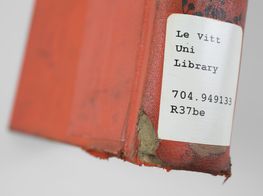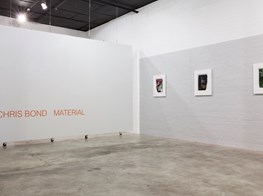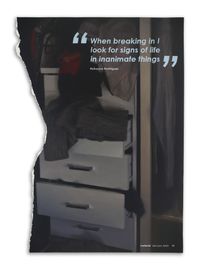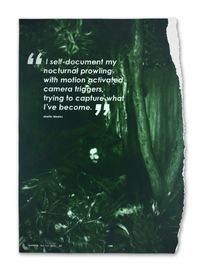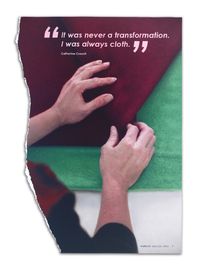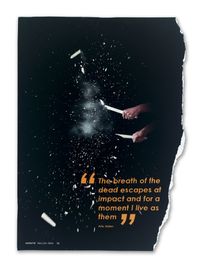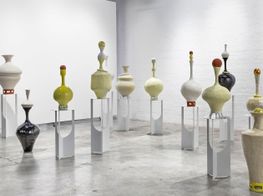Chris Bond at THIS IS NO FANTASY + Dianne Tanzer Gallery, Melbourne
Chris Bond is well known for his exquisite paintings that look like books. Playing with concepts of authenticity and identity, his work involves the invention and embodiment of fictional artists, writers, organisations and scenarios that assist with the creative act. These inventions are presented as painted facsimiles of imagined books, magazines, exhibition catalogues and correspondence.
His work is held in institutional collections including National Gallery of Victoria, Artbank, Bendigo Art Gallery, Monash University, RMIT and Shepparton Regional Art Gallery. He was included in the 2016 Adelaide Biennale of Australian Art, Magic Object, and is a finalist in the 2016 Archibald prize.
We spoke to the artist on the eve of his first solo show at THIS IS NO FANTASY + Dianne Tanzer Gallery in Melbourne.
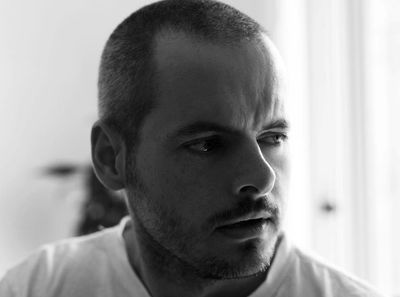
Tell us about your journey into art?
I’ve lived most of my life in my head, travelling to places I’ve never been to, having conversations with people I’ve never met. Visualisation has always been important, thinking about how to materialise my thoughts, about what might work, what’s best left unmade.
Around the age of 13, I discovered I had the ability to copy two dimensional forms. From there I began a long process of tuning, trying to get things to look the way I wanted, and establishing methodologies to manifest my ideas.
I’ve found that working with perverse forms of logic, forcing myself to submit to rules and boundaries that are often absurd, seems to be the best way to get things out of my head.
After two decades of practicing I’ve found myself in the fortunate position of being able to do what I want most days. Where I can’t do something, I invent someone or something to do it for me. I’m lucky, I think.
Your practice involves the invention and embodiment of fictional creative characters and scenarios that challenge the boundaries of reality and offer unique perspectives on the cultural landscape. Is there an underlying message you are trying to convey in your work?
There’s no message, it’s just me doing what I do. For me, ideally the work should sit in a space where any suggestion of message or meaning is unclear or just absent. That’s what I like in art that I look at. In the past I’ve created paintings that have been interpreted as satire or commentary on the art world, but they weren’t intended that way. Can’t stop interpretation, but sometimes it’s off the mark. If there is any message, it should either point to the methodology I use to invent, or be voiced by one of my characters, out of my hands.
How would you define yourself as an artist?
I’m part painter, performer, documenter, dreamer and hard worker. I like to breathe life into things that don’t exist, suggest alternative ways of looking at the world, and work through my obsessions. Where I fit in terms of contemporary practice is somewhere off to the side.
In your new exhibition, Material, you have invented artists and art collectives who in a direct reflection of your own practice, are concerned with the potential of embodied characterisations to foster new ways of seeing, thinking and expressing. Tell us about the exhibition?
I’d been thinking for a while of extending my interests in characterisation in multiple directions, specifically building a show where multiple voices can be heard simultaneously. Material has allowed this to happen. I’ve invented a contemporary art magazine, titled Material, which contains profiles of five artists and collectives who I perform as, in character. The cover of the magazine had been painted, as has documentation of the performances, in the form of torn out pages, with superimposed pull-quotes. Each of the artists share a fascination with acts of transformation, as do I. Although the artists that feature in Material are somewhat like me—sharing particular traits, exaggerating others—they perform actions that I’d be unlikely to normally undertake and seek to reach out to the world in unexpected ways. The paintings in the exhibition are a manifestation of the desire to experience different realities.
Where do you seek inspiration for the ‘invented’ characters in your work?
I often begin by inventing a name, and try to visualise the person who might inhabit it. After a couple of weeks I’ll add details: where they are from, what they do day-to-day, what their concerns are. Admittedly I’m fascinated by extremes of human behavior, and the pathology of my characters is usually tipped towards aberrance. They’re not people that are likely to exist, but that has never bothered me. Sometimes they’re just a critical voice. The defining inspiration comes from the act of characterisation itself, when I act as them. This is the part that I cherish the most as I get the chance to temporarily leave my body and mind.
Do you have a favorite work in the exhibition and if so why?
Martin Meeks. He was a fantastic character to inhabit and paint. He’s a therian, a condition of species dysphoria marked by an animal rather than human self-identification, and believes he’s an ocelot (a nocturnal wildcat). I feel a real affinity with him. He works at an occult library in Boston during the day and prowls at night, self-documenting with triggered cameras. I really like him. I got a lot of enjoyment inventing his character, acting as him, and painting him amongst night vision green foliage.
And what about your interest in printed media—books, catalogues, magazines—what draws you to this as a form for communicating your ideas?
It gives me a chance to play around with authorship and multiple voices. Within these publications there is a kind of truth expressed about the world, and I like to pervert that for my ends. I insinuate through these publications that the world is known and logical, when the opposite is usually true. I also like the wear that these publications accumulate over time through handling, there is a beauty in the way that they degrade that I find very appealing.
I was intrigued to read that you have a passion for Black Metal music and listen to it when in the studio (the exhibition catalogue includes a play list). Tell us about this interest and the role it plays in your work?
How much time have you got? Haha … I understand that most people don’t like the music that I listen to but it plays such an important role in my work, and gives me so much enjoyment, that I tend to bang on about it a bit. I’ve even incorporated into my doctoral thesis. It underpins much of what I do. On a very simple rhythm level, it establishes a kind of wave that I paint along to, and in terms of characterisation, has provided inspiration for my Norwegian character Tor Rasmussen, who has dominated much of my work of the last two years. One of the striking characteristics of Black Metal, and of critical importance to my work, is characterisation itself – namely, the employment of alter-egos by Black Metal musicians as a mediating force in the creative act. In music, more so than in any other art form outside of the dramatic arts, the construction of pseudonymous personae is a key part of the methodology of production and performance. In Black Metal, it is a crucial feature: the act of putting on a mask, whether literal or metaphorical, allows the musicians free reign to role-play transgressive fantasies.
I like to track what I listen to in the catalogues that I produce for exhibitions. There’s a definite link between what I listen to and how I work. In this show, I’ve wandered a little way off the Black Metal path and into the world of occult rock. I’m probably a little more relaxed as a result.
Your meticulous paintings, and indeed the studio shots in the exhibition catalogue, suggest a very disciplined approach to your work and a lengthy process? Describe the process, how long do you work on a typical painting?
The works take two to three months to complete, and to make things a little more streamlined I work on all of them at the same time, and rotate them day-by-day depending on how they’re drying. I keep very long hours, and I enjoy what I do, but I bring myself very close to cracking sometimes to keep on track with show deadlines. Deep down I love it. Some of the work is fairly rote, the text painting for example, but it’s a good chance to tune out, and just focus on simple things like keeping letters straight, or the same width, or evenly spaced. It’s the same sort of pleasure I used to get from jigsaws.
Do you ever work in other medium?
I work with sculpture occasionally, but it’s usually painted, I make photographs and text-based works, and I draw occasionally with graphite pencil, but I like oil paint—for its flexibility, its range of transparency, its fluidity.
You are currently a finalist in the Archibald prize, have shown at Art London and the Adelaide Biennale and now your first solo exhibition with THIS IS NO FANTASY + Dianne Tanzer Gallery. What else are you currently working on?
I have a solo exhibition with Darren Knight Gallery in Sydney in October, which features works from the Adelaide Biennial, plus two new works made in response to those works, and an exhibition of Tor Rasmussen related documentary and pseudo-documentary objects at La Trobe University Museum of Art in Bundoora, also in October. —[O]

